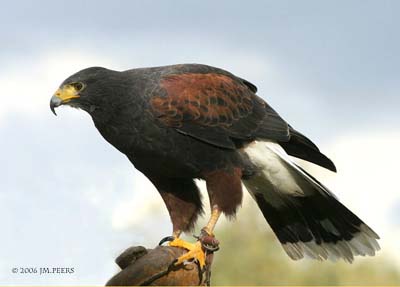
Harris’s Hawk
Parabuteo unicinctus
Accipitriforme Order – Accipitridae Family
BIOMETRICS:
Length: 46-59 cm ; Wingspan: 103-124 cm ; Weight: M : 735g ; F : 1050g
LONGEVITY: Up to 14 years
DESCRIPTION:
Harris’s Hawk is a beautiful hawk, with chocolate brown plumage. It shows conspicuous chestnut patches on shoulders, thighs and underwing coverts. Long tail is dark, with white base and tip, under and upperparts. Legs are yellow, with black claws. It has strong bill, with yellow base and dark tip.
Sexes are similar, with female larger than male.
Juvenile has streaked underparts. Shoulder patches are less distinct. We can see whitish primaries on underwing, distinctive in flight.

VOICE: SOUNDS BY XENO-CANTO
Harris’s Hawks make hissing noises. They can give alarm calls like prolonged and harsh “irrr”.
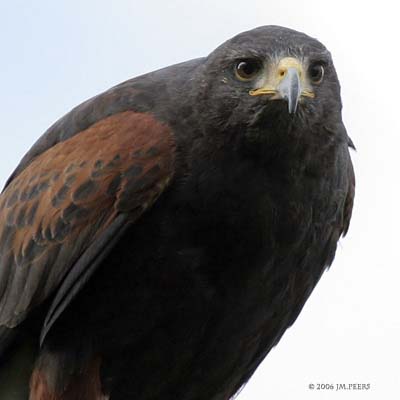
HABITAT:
Harris’s Hawk lives in semiarid woodlands and brush lands. We can also find it in tropical deciduous forests, and at 400 to 1000 metres of elevation. Recently, they come in urban areas.
RANGE:
Harris’s Hawk is resident in SW of United States and NW Mexico, from Baja California to S Arizona, New Mexico and Texas, also southward in Central and South America, to Chile and Patagonia.
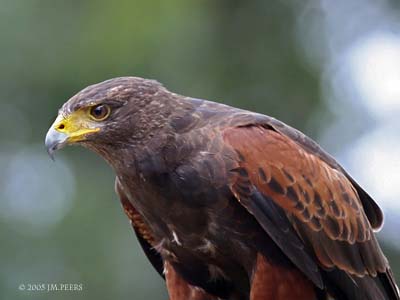
BEHAVIOUR:
Harris’s Hawk is gregarious. They may live in social groups, helping in nesting cycle and hunting. There is a strict hierarchy within these groups.
Alpha female (breeding female) is dominant to all hawks of the group. It may have a second female, subordinated to alpha female, but dominant all males of the group.
Alpha male (breeding male) is dominant to all other males in the group. Groups contain a beta male which may attempt to mate with alpha female, often unsuccessfully.
Finally, we may have several gamma birds, subordinated to alpha and beta individuals.
All members help to obtain food, defend territory and protect the nest.
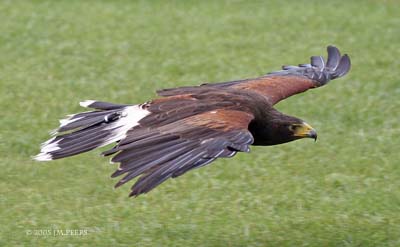
FLIGHT:
Harris’s Hawk is a fast flyer.
REPRODUCTION:
Harris’s Hawk’s nest is built in trees at 5 metres of height. It is a platform made with twigs, weeds and sticks. It is lined with soft materials, mosses, grasses and roots.
Female lays 2 to 4 eggs. Incubation lasts about 35 days, shared by both parents. Chicks fledge at about 40 days of age, and stay around the nest area during 2 to 3 months.
This species breeds all the year long, and can produce 2 or 3 clutches within a year. They practice cooperative breeding, with other birds helping for nest, incubation, feeding and defence, and this assistance increases nest success.
DIET:
Harris’s Hawk feeding is variable according to the food availability. They feed mainly on small mammals (rats and mice) but also birds and lizards. They hunt in group, and they are able to capture larger preys such as rabbits.
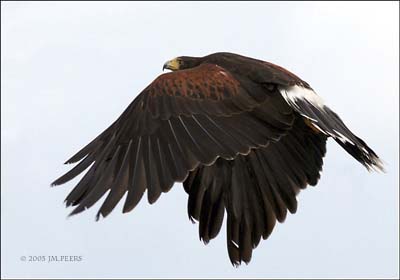
PROTECTION / THREATS / STATUS:
Harris‘s Hawk has some predators, such as Great Horned Owls, Common Ravens and coyotes.
Helpers of the group scan the surrounding, and they give alarm call if a predator come within the area.
This species is not threatened or endangered. Habitat loss is the major cause of its decline, with human disturbances.
Electrocution is responsible for the loss of half of the population, because they have habit of congregate on electrical transformers, where they are often electrocuted.
Fr: Buse de Harris
All : Wüstenbussard
Esp : Busardo Mixto
Ital : Poiana di Harris
Nd : Woestijnbuizerd
Russe : Пустынный канюк
Sd : Kaktusvråk
Photographs by Jean Michel Peers
His website: JMPN PHOTOGRAPHIE
Text by Nicole Bouglouan
Sources :
HAWKS, EAGLES AND FALCONS OF NORTH AMERICA by Paul A. Johnsgard - Smithsonian Institution Press - ISBN: 1560989467
FIELD GUIDE TO THE BIRDS OF NORTH AMERICA by National Geographic Society - National Geographic Society - ISBN: 0792274512
All About Birds (Cornell Lab of Ornithology)
Wikipedia (Wikipedia, The Free Encyclopedia)
The Hawk Conservancy Trust (Hilary Smith)
Animal Diversity Web (University of Michigan Museum of Zoology)